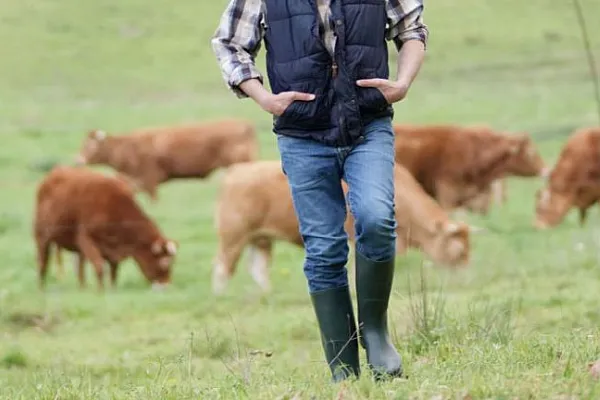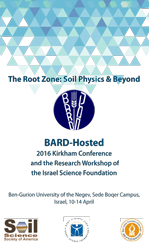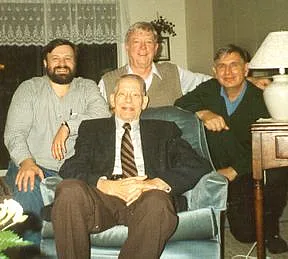
Kirkham Conferences
2025 Kirkham Conference: Fukushima, Japan

The SSSA Kirkham Conferences Committee has selected Fukushima, Japan, as the host site for the 2025 Kirkham Conference, scheduled for August 19-22, 2025 (with a student/early career networking event in the afternoon of August 18). The conference will be held at J-Village, located near the damaged nuclear reactor site in central Fukushima Prefecture. The conference is designed to encourage scientists to make organized, in-depth explorations of disciplinary and interdisciplinary subjects and novel ideas within soil physics in ways seldom possible at large meetings.
Abstract submissions are now closed.
Conference Title: Advancing Soil Physics: From Digital Innovation to Environmental Solutions
The conference will feature 4 scientific themes with two invited speakers for each theme. All additional presentations will be in the form of posters with 1-2 minute oral introductions. Additionally, the program will include a special presentation by the Kirkham Medalist (awarded every eight years). The four themes and associated speakers are:
Theme 1: Cutting-edge Technologies for Soil Management and Digitized Agriculture.
Exploring cutting-edge technology and methods for soil management and restoration through real- time sensing, digital twins and advanced modeling. This theme encompasses smart farming solutions, IoT sensor networks, artificial intelligence applications, and innovative soil information systems. We welcome contributions on sensor development, data integration frameworks, machine learning applications, remote sensing, precision agriculture implementations, and digital solutions for soil health monitoring and restoration. Special focus on novel approaches combining multiple data streams, cloud computing applications, and practical implementations of digital soil mapping for sustainable agriculture.
Invited speakers: Songchao Chen, Zhejiang University, China; Tarin Paz-Kagan, Ben-Gurion University of the Negev, Israel
Theme 2: Soil Structure as a Nexus of Biogeochemical and Hydrological Processes
Investigating the critical role of soil architecture in governing water movement, nutrient cycling, and biochemical processes across scales. We seek contributions examining pore-scale dynamics, aggregate stability impacts, root-soil interactions, and their influence on ecosystem services. Topics include advanced imaging techniques, structure-function relationships, scaling methods, modeling approaches linking physical and biological processes, and innovative methodologies for characterizing soil structural properties. Emphasis on multiscale analysis, from micropores to field- scale applications, and their implications for agricultural productivity and environmental quality.
Invited speakers: Sasha Kravchenko, Michigan State University, US; Teamrat Ghezzehei, University of California, Merced, US
Theme 3: Landscape-Scale Soil Hydrology: Bridging Scales and Systems
Examining the complex interplay between local and regional hydrological processes, from pedon to watershed scale. This theme explores the integration of vertical and lateral water fluxes, including surface-groundwater interactions, flood impacts on soil processes, and coastal soil dynamics. We welcome contributions on watershed modeling, terrestrial-aquatic linkages, climate change impacts on soil hydrology, and innovative approaches to scaling hydrological processes. Special interest in contributions addressing urban-rural interfaces, coastal soil systems, and advanced monitoring technologies for landscape-scale processes.
Invited speakers: James Kirchner, ETH-Zurich, Switzerland; Naoya Masaoka, Kyoto University, Japan
Theme 4: Environmental Fate and Transport of Soil Contaminants
Investigating the movement and transformation of contaminants in soil-water systems, including both surface and subsurface transport processes. We seek contributions on laboratory- and field- scale studies in various environmental compartments (e.g., surface runoff, vadose zone and saturated zone), innovative monitoring techniques and modeling approaches, and remediation strategies. Special focus on the fate and transport of radionuclides and emerging contaminants, and the development of sustainable remediation solutions.
Invited speakers: Markus Flury, Washington State University, US; Taku Nishimura, The University of Tokyo, Japan
Tours
The first-day tour is to the interim radioactive storage site. We will visit the Interim storage facility (https://www.jesconet.co.jp/interim_infocenter/en/index.html), where radio cesium-contaminated soils and materials have been removed and temporarily stored and operated by the Ministry of the Environment, Japan. We also visit the TEPCO Decommissioning Archive Center nearby (https://www.tepco.co.jp/fukushima_hq/decommissioning_ac/pdf/leaflet-e.pdf). After returning to J-Village, Dr. Masaru “Mizo” Mizoguchi of the University of Tokyo will present how radio cesium contamination affected people's lives; and
The second-day tour to Iitate Village, located 50 km north of J-Village, involves a bus ride of about 1 hour and 10 minutes. In Iitate Village, we will explore soil pits in both the forest and farmland to observe the soil profiles, including the radio cesium-contaminated layer and the layer replaced with fresh soil. We will also visit a previously heavily contaminated area in the village to see the restoration of farming facilities. Lunch will be prepared by villagers using locally grown vegetables, and we will have the opportunity to discuss their current lives and the impact of the six years of forced evacuation. Dr. Noriko Yamaguchi of NARO will present how radio cesium interacts with soil during lunchtime.
Tours are included in registration fees.
Registration, Lodging, Transportation
Registration will open soon with anticipated rates at $325 for students and $450 for professionals (which includes all lunches and dinners Tuesday-Friday). Hotel room reservations at J-Village will be available for conference attendees, only through the online registration form. Estimated lodging will be $450 for 5 nights ($90/night).
Our local hosts have developed a how-to guide for traveling by train from Tokyo airports to the J-Village station. From the station, it is approximately a ten minute walk to the hotel. View the train instructions here.

Welcome to the 6th Kirkham Conference, Brent Clothier, Kirkham Conferences Committee Chair
2022 Kirkham Conference Website
2022 Kirkham Conference Schedule
2022 Kirkham Conference Abstract Book (pdf)
Conference Information
The SSSA Kirkham Conference pre-conference was held virtually in the summer of 2021. The in-person Conference took place on Sunday, August 28 - Friday, September 2, 2022 at Kruger National Park (Skukuza Rest Camp), South Africa.
The Location: The location is the Skukuza Rest camp of the Kruger National Park in the north-eastern part of South Africa. Skukuza, situated on the banks of the Sabie river offers an ideal game viewing location and a wide variety of game can be observed during short road excursions from the camp and restaurants. Delegates will be safely housed in the rustic self-catering chalets and will enjoy a mid-week excursion to hydrological and soil research sites in this pristine savannah. Restaurants are also accessible in the camp.
The Theme: Since soil-water-atmosphere interactions in southern Africa are critically dependent on soil hydraulics, the development of soil physics in South Africa has a long history. With Agriculture, Ecology and now Mining heavily dependent on advances in soil physics, these topics will be included in a broad theme, suited to the region. Note the number of delegates is limited.
Visit the conference website for more information: https://cwrr.ukzn.ac.za/conferences/kirkham-conference-2020/

The Root Zone: Soil Physics & Beyond
Sede Boqer campus Ben-Gurion University of the Negev, Israel, 10-14 April 2016
 View the 2016 Program & Schedule (including speaker listing)
View the 2016 Program & Schedule (including speaker listing)- View the 2016 Kirkham Conference Abstracts
- Kirkham Gold Medal Honors Soil Scientist van Genuchten
- Follow the 2016 SSSA Kirkham Conference on Twitter: #KirkhamSoils
2016 Sponsors
- Binational Agricultural Research & Development Fund (BARD)
- Research Workshop of the Israel Science Foundation (ISF)
- Soil Science Society of America/Agronomic Science Foundation and the Lena and Maria van der Ploeg Fund and the Kirkham Fund
Objective
The symposium targets the root zone. The main objective of this symposium is to identify and prioritize knowledge gaps related to the various physical, biological and chemical aspects of water and nutrient flow, transport and uptake in this important region that is believed to control both agronomic production as well as environmental aspects related to water and agro-chemicals. The symposium will be a meeting point for researchers who study soil and roots from different disciplines and at different scales, seeking both pure scientific understanding of the processes as well as their application for the benefit of society. Special emphasis will be given to novel measurement and modeling tools at the various scales, to interdisciplinary research, and to the participation of young and mid-career graduate students and researchers.
Background
In recent decades, available water for agricultural use has been decreasing considerably due to both competition over existing water and an apparent reduction in the overall availability. At the same time, the need for food production is constantly increasing. Therefore, increasing resource utilization efficiency is of great importance. Clearly, the root system and its interaction with the soil play a key role in water, nutrients and gas transport. Understanding these key processes will facilitate increased efficiency that will eventually lead to improved food production, and reduced waste of resources.
The root zone is the main terminal through which plants obtain their resources. It is considered the most important (and least understood) component in the soil-water-plant-atmosphere continuum. The rhizosphere, termed in 1904 by Lorenz Hiltner is the interfacial region between the soil and the plant, and together with the soil immediately around it they control the movement of water, nutrients and other commodities into the plant. The rhizosphere can be generally divided into three regions: the endorhizosphere, which is the inner most part and includes portions of the cortex and endodermis , the rhizoplane, that is the medial zone directly adjacent to the root including the root epidermis and mucilage, and the ectorhizosphere, the outermost zone, which extends from the rhizoplane out into the bulk soil. The physical, chemical, and biological functionality of the rhizosphere’s subsections and of the soil around them, and their measurements are necessary for understanding the rhizosphere’s functionality in its entirety.
Analyzing the root zone in terms of functionality, we identify several key processes and data requirements that must be addressed individually, and then mutually, in order to understand the root zone. These include: a) water flow in the vicinity near the roots and across the root interface (uptake); b) nutrient transport and uptake; c) root respiration and soil aeration; d) root morphologies and mechanics and their dynamics; e) non-invasive measurements at various scales; f) the rhizosphere heat regime; and g) the rhizosphere microbiome. In the following, we elaborate on each of these specific fields of interest, tentatively identifying several key questions for discussion.

Exploring Frontiers in Soil Physics
The 2012 Kirkham Conference was held at the Wharerata Homestead of Massey University in Palmerston North, New Zealand over 28-30 November 2012. Invited speakers gave keynotes addresses on the contemporary soil physics’ themes of: up scaling, defining the effective properties of soils, relating structure to function, water repellency and unstable flows, plants and soil, microbial diversity and ecological economics. The theme for the 2012 Kirkham Conference was Exploring Frontiers in Soil Physics.
The 2012 Kirkham Conference was held at the Wharerata Homestead on the campus of Massey University, some 3 km from the city centre of Palmerston North, in the province of Manawatu in the lower half of the North Island of New Zealand. Auckland is New Zealand’s major city at the top of the North Island of New Zealand. In a geographic sense, Palmerston North looks a bit like Ames, Iowa, the university hometown of the Kirkhams – except for the backdrop of mountains, flowing rivers, and volcanoes!
Wharerata homestead was originally built in 1901 to a C.T. Natusch (http://eng.archinform.net/arch/58320.htm) design for Mr Arthur Edward Russell, a successful farmer from the neighbouring province of Hawke’s Bay. ‘Whare’ (pronounced -forry) is Maori for house, and ‘rata’ (pronounced ra – ta) is Maori for red. Mr Russell was nicknamed "Rata" by local Maori - thanks to his prolific fiery red beard. And when the time came to decide on a name for his new home in the Manawatu, Arthur decided on "Wharerata” – or ‘house of the red beard’! Gifted to Massey University in 1949, Wharerata was initially used simply as a lecture space, but it has now evolved into Manawatu’s premiere function centre. Further details are available from: www.wharerata.co.nz/modules/content/content.php?content.6
Why New Zealand?
The Kirkham Family has had a long-standing and vital connection with New Zealand, and the 2012 Kirkham Conference will commemorate these links. Don’s father, Francis Washington Kirkham, first visited New Zealand in March 1896 as a Mormon missionary. He spent 3 years on missionary service in New Zealand and a photo below shows him, with his colleagues and local Maori, during this time. He returned for 6 months in 1916, during which he wrote the book “Kirkham’s Maori Grammar”, a grammatical treatise of the language of the indigenous Polynesian people of New Zealand, the Maori. Maori people use the term tangata whenua (literally, "people of the land") to describe themselves in a way that emphasises their close relationship with a particular area of land and its soil. There is a close connection between the Kirkhams, New Zealand, and its soils. But there’s more …
Francis returned to New Zealand with his wife Marguerite in January 1962 and they spent 4 months Down-Under. Upon his death, in her write-up of Francis’s life, Marguerite wrote “One of the great loves of his life was the land of New Zealand and its people … [and during his 4-month visit in 1962] Francis gave over eighty talks to audiences during this short period, many of which were in the Maori language.”
Next, Don and Betty Kirkham visited New Zealand in February 1981 so that Don and Betty could attend the international conference at Massey University on Soils with Variable Charge. Then, Don and Betty’s daughter, Mary Beth Kirkham, a professor at Kansas State University, spent three sabbaticals in New Zealand; first in 1991, and then again in 1998 and 2005. She worked with the Crown Research Institutes of Plant and Food Research, and Landcare Research. She has even enjoyed being a guest at Wharerata – the location for the 2012 Kirkham Conference. So New Zealand seems to be exactly the right place to hold the 2012 Kirkham Conference.

The 2008 Kirkham Conference was held 24-26 February 2008 at the University of California at Davis (UCD, in Davis, CA. The theme of this conference was "Soil Physics – Research on the Frontiers of Earth’s Life Support System."
The Kirkham Conference honors the late Don Kirkham, Curtiss Distinguished Professor of Agriculture and Professor of Physics, and his wife Betty and is intended to be focused on critical issues in soil physics and hydrology. Ten distinguished speakers addressed unresolved soil-water questions.
The 2008 conference was sponsored by the Soil Science Society of America and the UCD Department of Land, Air and Water Resources.
For more information about this conference, visit the website maintained by University of Arizona.

The 2004 Kirkham Conference was held October 28 and 29, at Utah State University (USU) in Logan, UT, where Don Kirkham taught mathematics and physics. It was at Utah State University that Don met his wife, Betty, and became interested in soil physics.
Ten distinguished speakers addressed latest insights regarding physical and biological soil processes across different scales.
The 2004 conference is sponsored by the Soil Science Society of America, the USU Department of Plants, Soils and Biometeorology, and the USU Soil Physics Group
For more information about this conference, visit the website maintained by University of Arizona.

The first Kirkham Conference was held Nov. 2 and 3, 2000, at Iowa State University. The conference honors the late Don Kirkham, Curtiss Distinguished Professor of Agriculture and professor of physics, and his wife Betty. It was sponsored by the Soil Science Society of America, the Iowa State Water Resources Research Institute and the Iowa State University Department of Agronomy.
This first Kirkham Conference focused on scale issues in soil and hydrology.
For more information about this conference, visit the website maintained by University of Arizona.
About the Kirkham Conference
The Kirkham Conferences are topical meetings to encourage scientists to make organized, in-depth explorations of disciplinary and interdisciplinary subjects of soil physics in ways seldom possible at national, or international meetings.
These conferences are held every four years and can be held almost anywhere in the world, preferably in coordination with a related national or international meeting. Each conference focuses on a special topic and provides timely debate and development of newly emerging research ideas and inquiries. Attendance is generally fewer than 50 people.
Scope & Objectives
- Provide timely impetus to the development of newly emerging critical research.
- Bring together active researchers in soil physics and related sciences to promote debate and interaction.
- Enable participants to exchange ideas during the course of the meeting regarding the continued evolution of programs that enhance, develop and communicate knowledge of soil physics and its application to the global environment.
Guidelines
Kirkham Conferences are completely off-the-record. Written papers shall not be required; speakers shall not be quoted; and the recording of lectures by tapes, etc., and the photography of slides are prohibited. All steps possible should be taken to promote completely free discussion among participants. The outcome of the conference shall be publicized only in broad outline.
Conferences should be planned to serve a real and valid need not now filled by other technical meetings. Reporting new, unpublished and even incomplete concepts and results should be encouraged.
Conferences should be devoted to soil physics topics in which experiment, theory and application are of major importance, and they should not only educate but also stimulate further discussion and innovation.
History

In all fields of society jumps in progress have been realized through the accomplishments of exceptional men and women. It is appropriate that society honors and thanks people like Don Kirkham. The discipline, numerous individuals, and society have profited from his wisdom, energy, and charity. It was the desire of all those who took part in the establishment of the Kirkham Conferences that these meetings foster soil physics, and inspire future generations of soil physicists in the spirit, and in the memory of Don and Betty Kirkham.
